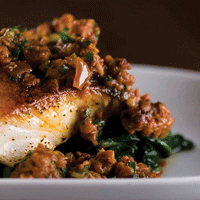When Toshi Karino and Kazu Kawashima developed their unique fusion menu for Calgary’s Carino Japanese Bistro, they may not have been thinking about the latest restaurant research. But, as their logo of a geisha on a Vespa so aptly illustrates, Canadians love Italian and Japanese flavours.
“In the latest full-service dining report, Canadians were asked which ethnic food they would order most frequently and Italian was number 1,” says Joel Gregoire, analyst for the NPD Group, “but Japanese was also in the top five.”
The NPD data shows servings of ethnic foods grew in all restaurants by four per cent in the past year, but Mexican food outpaced others, surging by seven per cent.
And, with current immigration patterns, it’s not surprising that Thai, Japanese and Indian continue to dominate, says Gregoire, but restaurateurs are getting creative with foreign flavours. “It’s a competitive market in major urban centres,” he says, “with restaurants looking for that point of differentiation. Japanese-Italian fusion — I’d like to try that.”
Andrew Waddington of Toronto’s FsStrategy consultancy firm agrees. Ethnic lines continue to blur in the restaurant kitchen, he says, with “cooking methods being borrowed from every cuisine, from stir-fry and tacos to confit.”
It’s all part of the globalization of our lives, in a world where a multi-ethnic dining experience is the new normal. A chipotle pork taco with kimchee, or a pizza topped with butter chicken, combines our love of spice and innovation.
According to the NPD “Full-Service Restaurant Chain Menu Tracker,” Indian and Mexican items are popping up more often on Canadian restaurant menus, with Indian foods up 35 per cent and Mexican more than doubling year over year, up 108 per cent in 2012.
“I see Latin showing up, as has real traditional Spanish in Toronto where two of the top restaurants in a recent survey were Spanish,” adds Waddington. “Though we look at the top 50 chains for our numbers, they all look to independents for inspiration.”
And, the new love of Latin flavour runs the gamut, from authentic Spanish spots, serving imported Jamon Serrano, to the ubiquitous fish taco. In the QSR category, Mexican is on the rise, whether it’s the street eats at Arturo’s Mexico-to-Go food cart in Vancouver or the homegrown Burrito Boyz chain in southern Ontario.
Denver-based Qdoba Mexican Grill (owned by Jack in the Box Inc.), one of the largest fast-casual concepts in the U.S., recently cracked the Canadian market with franchises opening in Brandon, Man., and London, Ont. Qdoba has 600 stores in 44 states and 70 to 85 new locations in North America planned for 2013. “Our interest in entering Canada had a lot to do with the fresh, healthy trends that exist there, and part of this is the growth in the ethnic food category across the country,” says John Dikos, Qdoba’s director of Franchise Development. “The Mexican food segment has been under-represented and expansion into Canada seemed like a natural extension of our brand.”
Qdoba differentiates itself with its fresh, made-from-scratch fare, says Dikos. Its employees cut and fry tortilla chips daily, making fresh guacamole and grilling marinated meats to order, and the counter service puts customers in control of their choices. “Everything is made fresh in front of the guest, they can customize their order to fit their exact dietary needs and taste preferences,” says Dikos.
Meanwhile, sandwiches are a big place where ethnic trends collide. Corn tortillas (the gluten-free option) and arepas (savoury corncakes made with cornmeal or corn flour) are standing in for the bread at places such as Toronto’s Arepa Café, where the cooks recreate an authentic Venezuelan diner experience. Their version of the South American snack is filled with a variety of tasty combinations, from roasted chicken and avocado ($9.25) to adobo pork roasted with annatto ($8.75) or the avocado, black bean, plantain and cheese vegetarian arepa ($9.75). With warm queso fresco salad ($11.50) or chayote coleslaw ($7.50) on the side, it’s a simple meal that’s faithful to its roots.
Latin American flavour is an underlying thread in the international tapas menu at Calgary’s new Candela Lounge, too. Chef and co-owner, Rogelio Herrera, was born in Columbia and says his customers are world travellers who know Latin food. “Ten years ago it was the fake Tex-Mex thing, but that’s over,” says Herrera. “People want the real thing; they want the bold flavours that Latin cuisine can provide.”
But, Herrera is quick to point out that his tapas menu at Candela borrows from many cultures. “It could be sushi or the little snacks we do in Latin America,” he says, “It’s about sharing the food.” Tapas, he says, allows diners to be adventurous, because they don’t need to make the “commitment” to an entrée to try something new. But, it also means every plate must be bursting with flavour. “Nothing on the plate can be flat,” he says, pointing to combinations ranging from papas fritas with spicy bravas sauce ($8) and pork belly chicharrón with black bean and tomato salsa ($9), to braised lamb and pork albondigas with manchego ($10) or red curry-braised beef short-rib taco and heirloom carrot slaw ($12).
But, as small plates or tapas become the norm, diners are also seeking a true Spanish experience. That’s what’s on offer at Ox & Angela in Calgary. Owners Jayme MacFayden and Kelly Black researched Spain’s specialties before opening their his- and-hers-inspired space — Ox being the dark, masculine cocktail bar side and Angela the lighter, brighter dining room, with both offering the same sharable dishes. From the honey-glazed almonds encrusted in smoky Spanish paprika ($4) to the individual pans of paella loaded with seafood, chicken and chorizo ($14 pp/min. two), or pintxos skewers ($2.50 each) and chunks of Manchego cheese drizzled in Pomegranate molasses ($7), this is Spanish noshing at its finest.
Chef Steve Smee says Spanish-American chef José Andreas — and his four Jaleo tapas bars — has been an inspiration for his food, which combines local and imported ingredients. And, diners are embracing it all, from albodigas, meatballs made with Alberta lamb ($13), to grilled sardines with orange-caper vinaigrette ($11), a perfect match with a dry Manzanilla sherry. “Spanish wine and food culture has such deep roots, there’s just so much to explore,” says Smee.
In Victoria, crispy fried octopus with preserved lemon ($6) and salt-cod fritters ($5) are on the bar menu at the new Catalanos restaurant in the Magnolia Hotel, where chef Aaron Lawrence is making fresh chorizo in house, too. Co-owner Tom Ferris, who also has a special Spanish menu every Sunday at his popular Ferris’ Oyster Bar, has plans to expand that venue with a Spanish tapas bar later this year.
It’s similar at España in Vancouver, where chef Neil Taylor and partner, Ed Perrow, have created a cosy, 40-seat tapas bar, with a menu that changes constantly. For example, recently the local mussels were cooked in cider with chorizo and butter beans with wild spring onions ($8), and the bar snacks included fried chickpeas with smoky Spanish paprika ($4) and nutty slivers of aged Serrano ham ($10).
And, like the true Spanish tapas bar, we’re seeing tiny Spanish spots such as Vancouver’s Sardine Can or Chorizo & Co. The latter is a new Spanish deli in downtown Victoria, where Friday night flamenco guitar matches perfectly with the ever-changing menu of bocadillo ($8.50), featuring house-made chorizo or combos such as chicken breast with raisin jam, Mahon cheese and honey aioli, plus small bites such as albondigas, boquerones (marinated fresh anchovies) or crispy fried olives stuffed with blue cheese, and Saturday night paella feasts.
Interestingly, the data from FsStrategy’s “Canadian Chain Restaurant Industry Review” also indicates authenticity is key in ethnic ingredients, with specialty cheeses, specialty peppers, aged premium meats and specialty nuts appearing more on the 2012 menus of Canadian chain restaurants. “If that’s an ingredient like buffalo mozzarella or chorizo, if it’s not imported, it’s made locally in the traditional artisan way,” Waddington says. “Diners know better.”
And, whether it’s Japanese sushi, tacos or Spanish tapas, it all makes for a convivial, casual, social style of dining that continues to gain ground, cherry picking flavour and fun from the world of ethnic food.




















